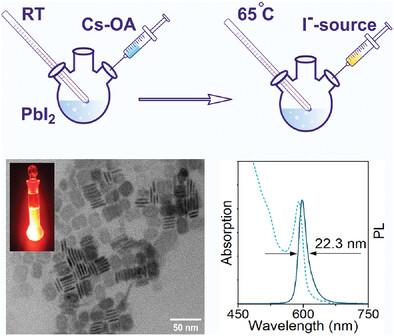Systematic Study of the Synthesis of Monodisperse CsPbI3 Perovskite Nanoplatelets for Efficient Color-Pure Light Emitting Diodes
IF 13
2区 材料科学
Q1 CHEMISTRY, MULTIDISCIPLINARY
引用次数: 0
Abstract
Metal halide perovskite nanoplatelets (NPls) possess ultra-narrow photoluminescence (PL) bands tunable over the entire visible spectral range, which makes them promising for utilization in light-emitting diodes (LEDs) with spectrally pure emission colors. This calls for development of synthetic methods toward perovskite NPls with a high degree of control over both their thickness and lateral dimensions. A general strategy is developed to obtain such monodisperse CsPbI3 NPls through the control over the halide-to-lead ratio during heating-up reaction. The excess of iodine precursor changes the chemical equilibrium, thus yielding monodisperse (3 monolayers in thickness) CsPbI3 NPls whose PL width constitutes ≈22 nm, while the lateral dimensions of NPls are determined by choice of precursor and by the reaction temperature. Postsynthetic cation exchange on the A-site of the perovskite lattice allows for the tuning of the PL peak position, while simultaneous removal of the excess ligands and the surface passivation allows for improvement of the PL quantum yield to 96% and ensures superior stability of optical properties upon storage. Electroluminescent LEDs with the peak values are fabricated for the external quantum efficiency and luminance being 9.45% and 29800 cd m−2, respectively, and a narrow (≈26 nm) electroluminescence peak at 601 nm.

求助全文
约1分钟内获得全文
求助全文
来源期刊

Small
工程技术-材料科学:综合
CiteScore
17.70
自引率
3.80%
发文量
1830
审稿时长
2.1 months
期刊介绍:
Small serves as an exceptional platform for both experimental and theoretical studies in fundamental and applied interdisciplinary research at the nano- and microscale. The journal offers a compelling mix of peer-reviewed Research Articles, Reviews, Perspectives, and Comments.
With a remarkable 2022 Journal Impact Factor of 13.3 (Journal Citation Reports from Clarivate Analytics, 2023), Small remains among the top multidisciplinary journals, covering a wide range of topics at the interface of materials science, chemistry, physics, engineering, medicine, and biology.
Small's readership includes biochemists, biologists, biomedical scientists, chemists, engineers, information technologists, materials scientists, physicists, and theoreticians alike.
 求助内容:
求助内容: 应助结果提醒方式:
应助结果提醒方式:


